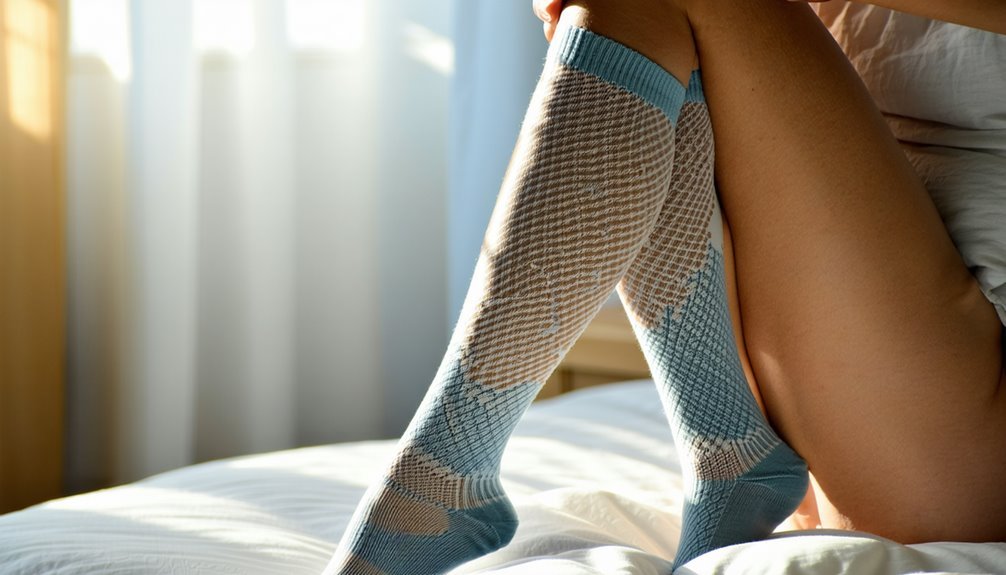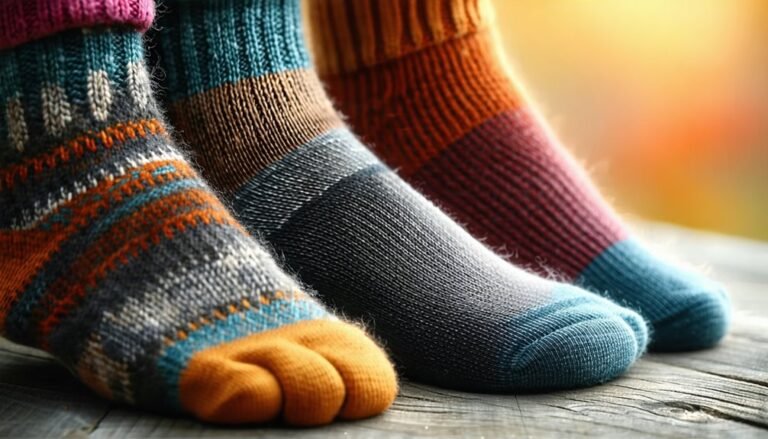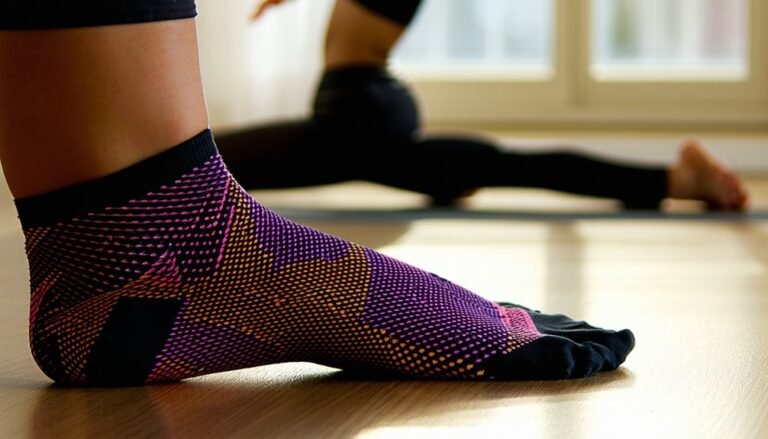Can Compression Socks Help Varicose Veins?
Compression socks can indeed help manage varicose veins by enhancing venous return and alleviating associated discomfort. Applying graduated pressure, these socks improve blood flow and reduce venous stasis, beneficial if you're on your feet a lot. Selecting the right compression level is key for effectiveness and safety. While offering non-invasive management, they're not a cure but a preventative measure against worsening symptoms. To uncover further insights into compression therapy and other treatment options, there's more ahead.
Understanding Varicose Veins
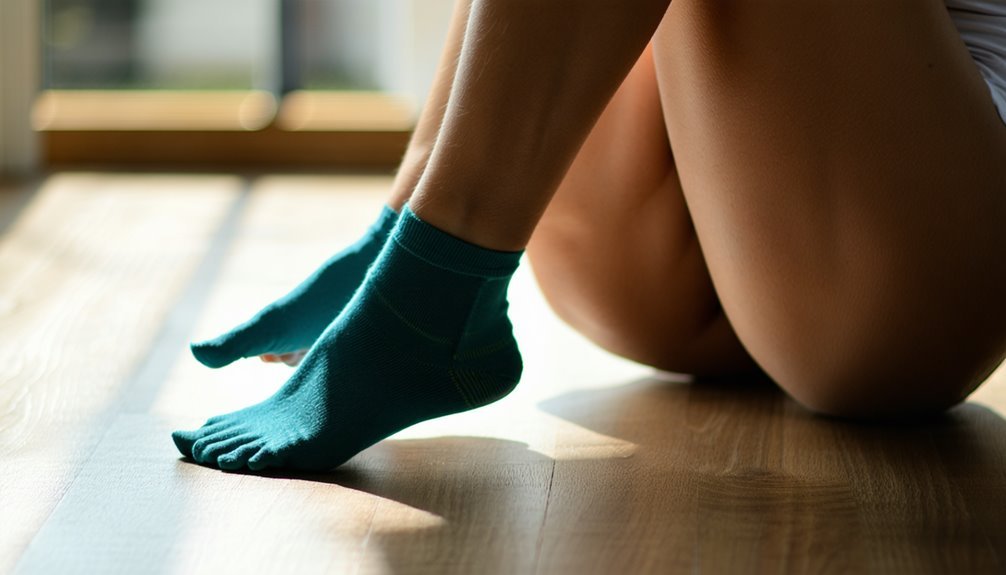
Varicose veins, a common vascular condition, occur when veins become enlarged, twisted, and overfilled with blood. You're likely to find them appearing mainly in the legs due to increased pressure from standing and walking. The causes of varicose include weakened or damaged vein walls and valves, often attributed to aging, genetic predisposition, pregnancy, or obesity. When these valves malfunction, blood pools, causing vein enlargement. Symptoms of varicose often present as aching pain, heaviness, and visible blue or dark purple veins; in severe cases, swelling, throbbing, or skin ulcers might develop. Understanding these causes and symptoms is critical for ensuring your safety and managing potential discomfort effectively. Recognizing early signs can guide you towards seeking preventive or therapeutic measures.
The Role of Compression Socks
You'll find that compression socks play an essential role in managing varicose veins by enhancing venous return. By applying graduated pressure to your legs, these socks improve blood circulation, effectively reducing venous stasis. This mechanism not only alleviates the discomfort associated with swelling symptoms but also aids in preventing further vascular complications.
Improve Blood Circulation
Although often underestimated, the role of compression socks in improving blood circulation is both significant and well-documented. By exerting graduated pressure on your legs, these socks enhance blood flow from the extremities back to the heart. This process is vital for maintaining ideal circulation health, especially if you're dealing with varicose veins. Compression socks apply more pressure at the ankle and gradually reduce it up the leg, effectively counteracting the effects of gravity. This mechanism guarantees that blood doesn't pool in your veins, reducing the risk of venous congestion. For those concerned about safety, it is important to select the appropriate compression level. Consulting with a healthcare professional can help you reap the circulatory benefits while minimizing potential risks.
Reduce Swelling Symptoms
When dealing with varicose veins, managing swelling becomes crucial, and compression socks play an essential role in this effort. By applying consistent pressure to your legs, these socks promote circulation and reduce fluid buildup, offering significant swelling relief. The compression benefits are particularly effective for those on their feet for extended periods, as they prevent blood from pooling in your veins.
Here's a quick breakdown:
| Benefit | Explanation |
|---|---|
| Compression Benefits | Enhances blood flow, reducing vein pressure |
| Swelling Relief | Minimizes leg swelling by decreasing fluid retention |
| Safety | Provides a secure, non-invasive management solution |
| Accessibility | Available in various sizes and pressure levels |
How Compression Socks Work
When you wear compression socks, they apply graduated pressure to your legs, which enhances venous blood flow back to your heart. This pressure reduces venous pressure by narrowing the diameter of the veins, allowing for more efficient circulation. As a result, it helps mitigate the symptoms of varicose veins by preventing blood from pooling in the lower extremities.
Pressure Improves Blood Flow
While it's easy to overlook the mechanics behind compression socks, understanding how they improve blood flow is vital for managing varicose veins effectively. These socks exert graduated pressure on your legs, with the highest compression at the ankles, decreasing as they move upwards. This graduated pressure enhances vascular health by promoting efficient blood flow back to your heart. By gently squeezing your leg tissues and veins, compression socks counteract the effects of gravity, reducing the pooling of blood. This pressure guarantees that blood moves smoothly, preventing stagnation and minimizing symptoms associated with varicose veins. For those concerned about safety, it's important to select the right compression level tailored to your needs, making sure they fit snugly but comfortably, without cutting off circulation.
Reducing Venous Pressure
By understanding the mechanics of compression socks, you can effectively reduce venous pressure associated with varicose veins. These socks apply graduated pressure, strongest at the ankle, gradually decreasing up the leg. This pressure management helps push blood upwards, improving circulation and supporting venous health. It prevents blood from pooling, which reduces the risk of further venous complications.
When you wear compression socks, they provide external support to your veins, enhancing blood flow efficiency. They counteract the effects of gravity, which can exacerbate venous insufficiency. This systematic approach to pressure management promotes a safe, non-invasive method to address venous health concerns. As a result, the consistent use of compression socks can alleviate symptoms and slow the progression of varicose veins, contributing to overall leg health and comfort.
Benefits of Wearing Compression Socks
Although often overlooked, compression socks offer significant benefits for individuals dealing with varicose veins. They work by applying graduated pressure to your legs, enhancing blood flow and reducing discomfort. From patient experiences, it's clear that many find relief from swelling and leg fatigue, resulting in improved daily comfort and mobility. Furthermore, modern compression socks address fashion considerations; they come in various styles and colors, allowing you to maintain your personal style while ensuring health benefits.
Safety is paramount, and these socks provide a non-invasive option to manage symptoms effectively. By supporting vein function and minimizing venous pressure, they can prevent the progression of varicose veins. Embrace compression socks as part of your proactive approach to vascular health, feeling assured in both function and fashion.
Types of Compression Socks
When selecting compression socks for varicose veins, consider the graduated compression levels, as they dictate the pressure applied from the ankle upwards, vital for effective blood flow support. You'll also want to examine materials and durability, ensuring they provide the necessary elasticity while withstanding daily wear. Finally, assess size and fit options, as an accurate fit is essential for maximizing therapeutic benefits and comfort.
Graduated Compression Levels
Graduated compression levels are an important feature to evaluate when selecting compression socks for managing varicose veins. This design provides varying degrees of pressure along the leg, offering graduated support that's essential for improving blood flow. Understanding different compression levels is critical; they range from mild (15-20 mmHg) to extra firm (30-40 mmHg). Each level serves a unique purpose, targeting specific vein conditions and user comfort. For mild symptoms, lower levels suffice, while severe cases may require higher pressure. It's important to choose the right level to guarantee safety and efficacy, avoiding potential risks like restricted circulation. Always consult a healthcare professional to determine the most suitable compression level tailored to your needs, guaranteeing maximum therapeutic benefits and safety.
Materials and Durability
Selecting the right compression level is just one aspect of choosing compression socks for varicose veins; the materials and durability are equally important. When evaluating fabric types, consider those that offer breathability and moisture-wicking properties, such as nylon, spandex, and polyester blends. These materials not only enhance comfort but also guarantee your skin remains dry, preventing irritation. For sock longevity, opt for reinforced stitching and high-quality elastic fibers that maintain compression levels over time, vital for consistent therapeutic benefits. It's important to choose socks that withstand daily wear and washing without losing effectiveness. Prioritizing these factors will give you a reliable, long-lasting solution in managing varicose veins, promoting both comfort and vascular health. Safety and durability should never be compromised.
Size and Fit Options
Understanding the size and fit options for compression socks is essential, as it guarantees maximum effectiveness and comfort. Accurate size measurement is your first step. Use a tape measure to determine the circumference of your ankle, calf, and sometimes the thigh, depending on the sock type. This ascertains that you select the right compression level and fit adjustments. Remember, a proper fit should feel snug but not constricting, as incorrect sizing can impede circulation.
Consider these factors:
- Ankle Circumference: Critical for determining the proper compression level.
- Calf Size: Ascertains that the sock won't slide down or cause discomfort.
- Leg Length: Essential for knee-high or thigh-high socks.
- Material Stretch: Affects how the sock conforms to your leg.
Prioritize these elements to enhance safety and efficacy.
Choosing the Right Compression Level
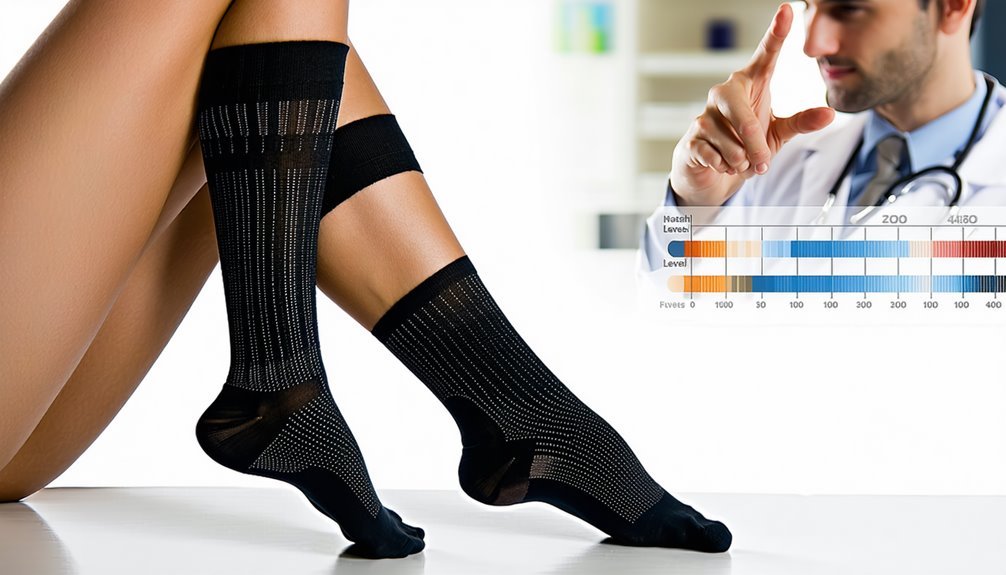
When considering compression socks for varicose veins, determining the appropriate compression level is vital for effectiveness and comfort. Compression levels are measured in millimeters of mercury (mmHg) and typically range from mild (15-20 mmHg) to extra firm (30-40 mmHg). Selecting the correct level depends on the severity of your symptoms and any medical advice you've received. Mild compression might be suitable for preventative care or mild symptoms, whereas moderate to firm levels are often recommended for more pronounced varicose veins. In addition to compression levels, choosing styles that suit your lifestyle and climate is important. Knee-highs, thigh-highs, and pantyhose options allow you to find the right fit. Always consult your healthcare provider to guarantee safety and best results.
Potential Risks and Side Effects
While compression socks are often recommended for managing varicose veins, it is important to be aware of potential risks and side effects. These socks, though beneficial, can pose certain challenges if not used correctly. You should watch for potential complications, such as skin irritation or adverse reactions. Allergic reactions to the material can occur, especially if you have sensitive skin. Monitor any changes in skin color or sensation, as these may indicate a problem.
Compression socks are beneficial but watch for skin irritation or allergic reactions, especially with sensitive skin.
Consider the following:
- Improper fit: Too tight socks can impede blood flow, causing discomfort.
- Duration of wear: Wearing them too long might lead to skin breakdown.
- Allergic reactions: Some materials may cause skin rashes.
- Underlying conditions: Conditions like diabetes require extra caution when using compression therapy.
Always consult with a healthcare professional before use.
Expert Opinions on Compression Therapy
Despite the potential risks and side effects associated with compression socks, many experts emphasize their effectiveness in managing varicose veins. Expert insights reveal that these garments apply graduated pressure, enhancing venous return and reducing leg swelling. Clinical recommendations often suggest using compression therapy as an initial intervention, especially for mild to moderate varicose veins.
You might wonder about the safety of these recommendations. Rest assured, medical professionals advocate for proper fitting and usage to mitigate any adverse effects. It's essential to consult with a healthcare provider to tailor the compression level to your specific condition. This guarantees maximum benefits while prioritizing safety. By following expert guidelines and clinical insights, you can confidently incorporate compression therapy into your varicose vein management plan.
Comparing Compression Socks With Other Treatments
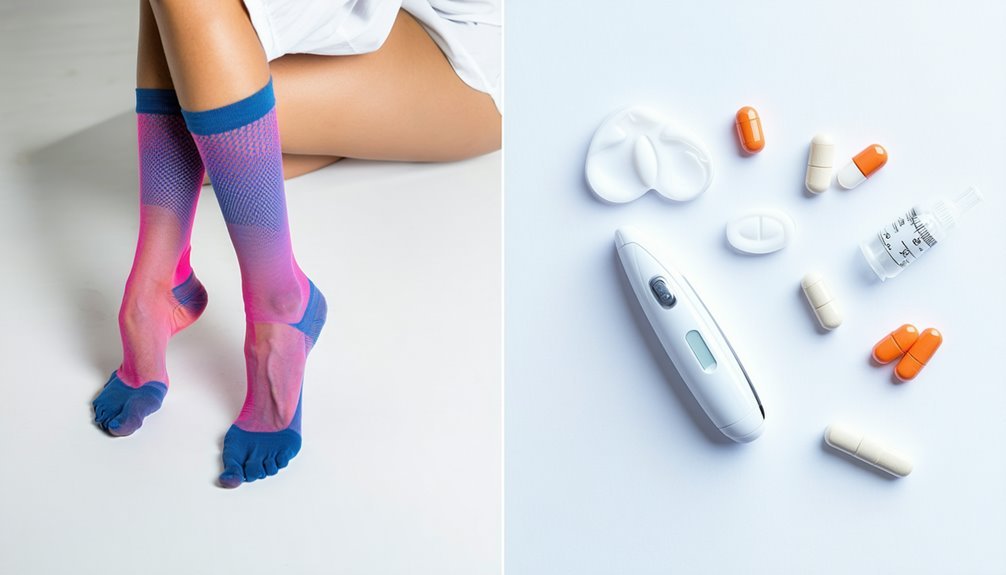
Although compression socks are widely recommended for managing varicose veins, it is crucial to compare them with other available treatments to make an informed decision. Varicose vein treatments offer varying degrees of effectiveness and invasiveness. Compression therapy alternatives like sclerotherapy, laser treatments, and surgery might be suitable depending on your condition's severity and your comfort level with potential risks. Consider the following when evaluating your options:
- Efficacy: How effective is each treatment in reducing symptoms and preventing progression?
- Safety: What are the associated risks and side effects?
- Invasiveness: Does the treatment require surgery or is it non-invasive?
- Recovery time: How long will it take to resume normal activities?
Tips for Effective Use of Compression Socks
Understanding the comparative aspects of varicose vein treatments can guide you in making an informed choice, yet the proper use of compression socks themselves is pivotal for maximizing their effectiveness. Adhering to best practices guarantees safety and efficacy. First, select the right compression level based on your physician's advice. Generally, a range of 15-20 mmHg is suitable for mild cases, while severe conditions might require higher pressure. Establish a consistent wearing schedule, typically donning the socks in the morning when your legs are least swollen. Remove them before bedtime to allow your skin to breathe. Ascertain proper fit by measuring your leg dimensions as instructed. Regularly inspect your socks for wear and tear, replacing them every three to six months for peak performance.
Frequently Asked Questions
Can Compression Socks Be Worn During Pregnancy for Varicose Veins?
You're wondering if you can wear compression socks during pregnancy for varicose veins. Yes, you can. They alleviate pregnancy symptoms, support circulation, and aid varicose vein prevention, ensuring both comfort and safety throughout your pregnancy journey.
How Long Should Compression Socks Be Worn Daily?
You should wear compression socks for 6-8 hours daily, depending on your compression levels. Guarantee proper fit and gradually increase wearing duration to optimize benefits while prioritizing safety and comfort. Consult a specialist for personalized advice.
Are There Specific Brands Recommended for Varicose Veins?
When considering brand comparisons for varicose veins, you'll find Sigvaris and Jobst highly recommended. Focus on sock materials like nylon and spandex for durability and elasticity, ensuring ideal compression. Prioritize safety by choosing FDA-approved options for best results.
Can Compression Socks Prevent the Development of Varicose Veins?
Imagine a safety net for your veins. Compression socks, as part of prevention strategies, can be effective. Coupled with lifestyle changes like exercise and weight management, they help reduce the risk of developing varicose veins.
Is It Safe to Sleep Wearing Compression Socks?
Sleeping in compression socks can be safe if they're properly fitted and made from breathable materials. However, sleep benefits may vary. Consult a healthcare professional to guarantee sock materials and compression levels suit your specific needs.

